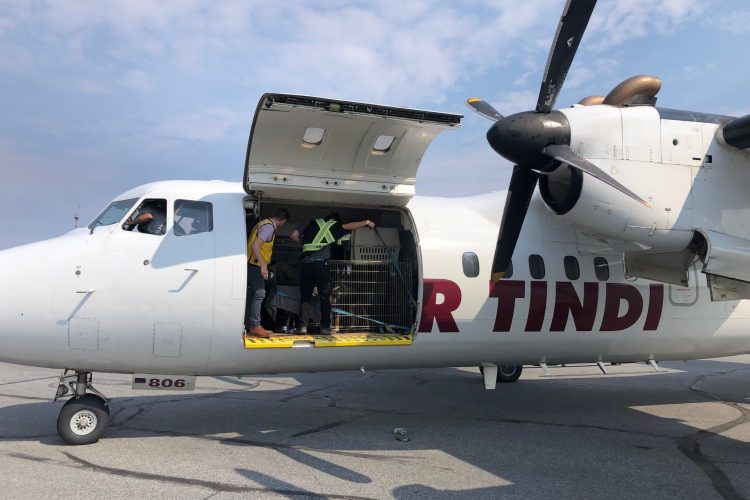Evacuation by air at Fort McMurray International Airport
- Like
- Digg
- Del
- Tumblr
- VKontakte
- Buffer
- Love This
- Odnoklassniki
- Meneame
- Blogger
- Amazon
- Yahoo Mail
- Gmail
- AOL
- Newsvine
- HackerNews
- Evernote
- MySpace
- Mail.ru
- Viadeo
- Line
- Comments
- Yummly
- SMS
- Viber
- Telegram
- Subscribe
- Skype
- Facebook Messenger
- Kakao
- LiveJournal
- Yammer
- Edgar
- Fintel
- Mix
- Instapaper
- Copy Link
Posted: 22 November 2023 | Jessica Lipton | No comments yet
Jessica Lipton, Manager of Marketing & Communications for the Fort McMurray Airport Authority, tells International Airport Review how the airport deals with wildfire season in the region and how it worked together with its local community to evacuate many residents this year.


Credit: Fort McMurrary Airport Authority
Canada’s 2023 wildfire season has had a record-setting year, burning nearly 17 million hectares of beautiful Canadian landscape to-date.
Included in that statistic is 60,500 hectares of the Boreal Forest surrounding Fort Chipewyan – Alberta’s oldest settled community, affectionately referred to by locals as “Fort Chip.” The community has a population of 1,200 people, made up of members of the Athabasca Chipewyan First Nation, Mikisew Cree First Nation, Fort Chipewyan Métis Nation, and hamlet residents of the Regional Municipality of Wood Buffalo.
Predominantly a fly-in, fly-out community, Fort Chipewyan is only accessible by road during winter months, when the Athabasca River freezes, and an ice road is constructed. Otherwise, access is limited to plane or boat. This presented major challenges when a wildfire threatened the community earlier this year.
On May 30, as fire encroached onto Fort Chipewyan, the Regional Municipality of Wood Buffalo (RMWB) stood up an Incident Management Team (IMT). As the risk of the fire intersecting with the community was assessed, it was decided the 1,200 residents needed to be evacuated.
RMWB’s IMT, reached out to the Fort McMurray Airport Authority (FMAA) for support. President & CEO Denean Robinson was immediately committed to helping, “We were eager to support the emergency response in any way we could,” says Robinson. “We have close ties to the beautiful community of Fort Chipewyan and were all very concerned for the safety of its residents.”
FMAA members Michael Sieger, Vice-President of Air Service and Commercial Development and Jessica Perry, Specialist, Route Development & Passenger Experience joined the IMT at the Regional Emergency Coordination Centre (RECC).
“We went to work quickly, contacting our charter and airline partners to garner support,” says Sieger. “McMurray Aviation, North Cariboo Air, Airco Aircraft Charters, WestJet, Summit Air, Air Tindi and Canadian North were quick to respond and send planes.” Sieger and Perry scheduled flights to take evacuees from the Fort Chipewyan Airport (CYPY) to the Executive Flight Centre – located on the Fort McMurray International Airport (YMM) campus. They quickly built a flight schedule for not only people, but cats, dogs, fire fighters, sprinklers, and cargo to support firefighting efforts.
CYPY is a small airport (5,000’x150’ runway, a single taxiway, and 325’x200’ apron) and typically handles 11 flights a week with aircraft accommodating 10-20 passengers (C208 and B1900C). For the evacuation, there was the need to accommodate multiple aircraft, able to carry up to 100 passengers at a time. Aircraft, including the C130, Dash 8-300/400, RJ100, C208, 1900C/D, and Dash 7 from multiple carriers, provided the critical airlift support to evacuate residents and their pets.
To avoid interference with aerial firefighting operations, a NOTAM was issued, limiting flights to those required for evacuation and firefighting operations only as authorized by Alberta Wildfire. At times, all flights had to be suspended due to poor visibility caused by smoke.
“With the considerable amount of air traffic going in and out of CYPY, we decided there was opportunity to further assist the RMWB by sending more staff,” says Sieger. Jeffrey Vader, Manager, Airport Maintenance, and Valerie Driz, Assistant Manager, Airport Maintenance were asked to help. They flew up on the first flight the next morning to support CYPY’s team with coordinating aircraft movements.
Vader and Driz provided crucial updates with passenger counts, enabling the RMWB IMT Logistics section to accurately track the air evacuation. They stayed until the last flight out.
When asked about the biggest overall challenges faced, Sieger and Perry both cited tracking of evacuees. Many had evacuated by boat and were checking in to different communities and Fort McMurray points of entry.
“The experience brought back memories and many emotions from the Horse River Wildfire in Fort McMurray in 2016. That was a scary day for our town, so I empathized with what Fort Chip residents were going through. We were anxious for confirmation that everyone had gotten out safely,” says Perry.
The evacuation was a success, and all residents were soon accounted for. Emergency response professionals were able to save the community from the fire, before anyone was injured, or any structures were lost. Evacuees received support from numerous organizations. “It was heartwarming to see so many organizations collaborate with the shared goal of helping the residents of Fort Chip,” says Perry. Executive Flight Centre, airlines, First Nations, SPCA, hotels, volunteers and Fuse Social are just several of the groups that were involved.
FMAA and RMWB employees have taken Incident Command System (ICS) training together. This shared practice has resulted in a strong relationship between the organizations, allowing for collaborative responses in emergency situations.
“I’m extremely proud of our team, everyone was willing and eager to help in whatever way they could,” says Robinson about FMAA’s efforts. “We were all so relieved once the residents were evacuated safely.”
Residents have since returned to their homes, and now the learnings from the experience are being shared by the RMWB with other communities being faced with evacuation due to nearby wildfires, such as the Northwest Territories.
Alberta Emergency Management Agency’s Northeast Alberta Field Officer Ian Fox is grateful for the FMAA’s assistance, “Their existing knowledge and regulatory expertise expedited the air process and removed much of the stress that could have been in play if folks unfamiliar with the carriers had been attempting to do what they have accomplished. Having the FMAA staff’s support was an absolute godsend.”


Jessica Lipton is the Manager of Marketing & Communications for the Fort McMurray Airport Authority, which owns and operates the Fort McMurray International Airport (YMM). Originally from Nova Scotia, Jessica has called Fort McMurray her home for nearly twelve years. She has found her passion for working in the aviation industry after holding previous PR roles in healthcare and oil and gas sectors.

















